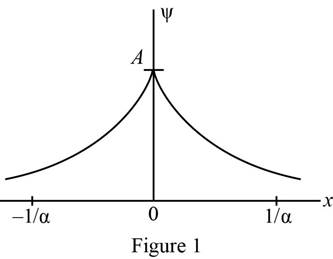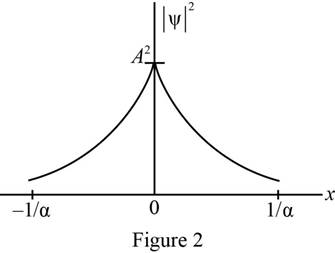
(a)
Plot of wave function as a function of
(a)
Answer to Problem 62CP
The wave function was plotted as a function of
Explanation of Solution
Write the given wave function of the electron.
Here,
Write the formula to calculate the probability of finding a particle in a certain range.
Here,
Refer equation (I) and plot the wave function as a function of
Figure 1 below shows the plot of wave function.

Conclusion:
The wave function was plotted as a function of
(b)
Plot of probability density as a function of
(b)
Answer to Problem 62CP
The probability density was plotted as a function of
Explanation of Solution
Write the given wave function of the electron.
Here,
Write the formula to calculate the probability of finding a particle in a certain range.
Here,
Refer equation (II) and plot the probability density as a function of
Figure 2 below shows the plot of wave function.

Conclusion:
The probability density was plotted as a function of
(c)
To show that
(c)
Answer to Problem 62CP
The
Explanation of Solution
Write the given wave function of the electron.
Here,
For the wave function to be a reasonable wave function, there are set of condition.
The
As
The
The
Conclusion:
The
(d)
To normalize the wave function.
(d)
Answer to Problem 62CP
The normalization constant of the given wave function is
Explanation of Solution
Write the given wave function of the electron.
Here,
Write the condition for normalized wave function.
The wave function is symmetric. Thus re-write the above condition.
Substitute equation (I) in the above equation.
Conclusion:
The normalization constant of the given wave function is
(e)
The probability of finding the electron in the range
(e)
Answer to Problem 62CP
The probability of finding the particle in the range
Explanation of Solution
Refer section (d) and write the given normalized wave function of the electron.
Here,
Write the formula to calculate the probability of finding a particle in a certain range.
Here,
Refer equation (II) in equation (III) to determine probability in range
Conclusion:
The probability of finding the particle in the range
Want to see more full solutions like this?
Chapter 41 Solutions
Physics For Scientists And Engineers With Modern Physics, 9th Edition, The Ohio State University
- Determine ψ∗ψ for the following wave functions:a) ψ(θ) = sin θ + icosθ b) ψ(x) = eiaxarrow_forwardA hypothetical one dimensional quantum particle has a normalised wave function given by (x) = ax - iß, where a and 3 are real constants and i = √-1. What is the most likely. x-position, II(x), for the particle to be found at? 0 11(x) == ○ II(2) = 0 ○ II(r) = 2/ O II(z) = 011(r) = ± √ +√ 13 aarrow_forwardBeing, Ψ = sin x, Φ = cos x and Θ = tan x, which of those functions could be a wave function?Why?arrow_forward
- What is the value N so that ψ(x) = N/(a2 + x2) can give rise to a valid probability density?arrow_forwardA particle is moving in a three-dimensional potential V (x, y, z)=-mo (2x² +y² +4z° ). If the mass of the particle is m, then what is the energy of the particle in the lowest quantum State? (a) (3+ v2 (b) ħo (c) (3+ V2) ħo (d) ħo 12arrow_forwardA quantum particle is described by the wave function ψ(x) = A cos (2πx/L) for −L/4 ≤ x ≤ L/4 and ψ(x) everywhere else. Determine:arrow_forward
- The probability density function (PDF) for electrons to be detected on the x-axis between 0 nm and 1.0 nm is shown below. What is the probability of finding the electron between x = 0.5 nm and x = 1.0 nm? |w(x)* (nm') 2.0 1.0 0.5 x (nm) 1.0arrow_forwardA quantum system is described by a wave function (r) being a superposition of two states with different energies E1 and E2: (x) = c191(r)e iEit/h+ c292(x)e¯iE2t/h. where ci = 2icz and the real functions p1(x) and p2(r) have the following properties: vile)dz = ile)dz = 1, "0 = rp(x)T#(x)l& p1(x)92(x)dx% D0. Calculate: 1. Probabilities of measurement of energies E1 and E2 2. Expectation valuc of cnergy (E)arrow_forwardAn electron moving in a box of length ‘a’. If Z1 is the wave function at x1 = a/4 with n=1 and Z2 at x = a/4 for n=2 find Z1/Z2arrow_forward
- Let Ψ (x, t) = (A / (a2 + x2)) exp (-i 2 π E t / h ) be a normalized solution to Schrodinger’s equationfor constants A, a, and E.(a) What is A in terms of a?(b) What is the potential function V(x)?(c) Evaluate Δx Δp. Is the uncertainty principle satisfied?arrow_forwardA thin solid barrier in the xy-plane has a 12.6µm diameter circular hole. An electron traveling in the z-direction with vx 0.00m/s passes through the hole. Afterward, within what range is vx likely to be?arrow_forwardIf an electron is in the n=3 state l =1, list the possible quantum states (n, l, ml,ms ).arrow_forward
 Principles of Physics: A Calculus-Based TextPhysicsISBN:9781133104261Author:Raymond A. Serway, John W. JewettPublisher:Cengage Learning
Principles of Physics: A Calculus-Based TextPhysicsISBN:9781133104261Author:Raymond A. Serway, John W. JewettPublisher:Cengage Learning Physics for Scientists and Engineers: Foundations...PhysicsISBN:9781133939146Author:Katz, Debora M.Publisher:Cengage Learning
Physics for Scientists and Engineers: Foundations...PhysicsISBN:9781133939146Author:Katz, Debora M.Publisher:Cengage Learning Modern PhysicsPhysicsISBN:9781111794378Author:Raymond A. Serway, Clement J. Moses, Curt A. MoyerPublisher:Cengage Learning
Modern PhysicsPhysicsISBN:9781111794378Author:Raymond A. Serway, Clement J. Moses, Curt A. MoyerPublisher:Cengage Learning Physics for Scientists and Engineers with Modern ...PhysicsISBN:9781337553292Author:Raymond A. Serway, John W. JewettPublisher:Cengage Learning
Physics for Scientists and Engineers with Modern ...PhysicsISBN:9781337553292Author:Raymond A. Serway, John W. JewettPublisher:Cengage Learning



